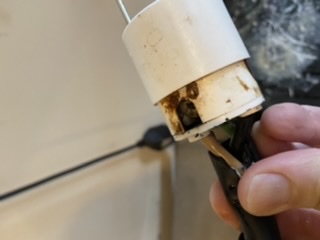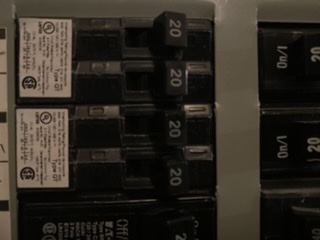You are using an out of date browser. It may not display this or other websites correctly.
You should upgrade or use an alternative browser.
You should upgrade or use an alternative browser.
Melting plastic
- Thread starter reuliss
- Start date

Help Support Homebrew Talk - Beer, Wine, Mead, & Cider Brewing Discussion Forum:
This site may earn a commission from merchant affiliate
links, including eBay, Amazon, and others.
Watts turned into heat because of resistance inside that connector. Either the wires aren't tight or the prongs aren't making a low resistance connection...
Thank you for the reply. What can I do to correct the absence of a low resistance connection?Watts turned into heat because of resistance inside that connector. Either the wires aren't tight or the prongs aren't making a low resistance connection...
I'd start by opening up that plug and taking a look inside as an autopsy because that connector is shot.
Check for tightness of the wires, and try to determine if the heat started at the wires and worked to the prongs, or the other way around.
Also, what does the element side look like?
Cheers!
Check for tightness of the wires, and try to determine if the heat started at the wires and worked to the prongs, or the other way around.
Also, what does the element side look like?
Cheers!
Those prongs look pretty bad too. If you can't shine them up with some steel wool, I'd replace the element. All that oxide and grunge on the prongs will increase contact resistance, and you may destroy the new receptacle even if the wires are tight.
Brew on
Brew on

For the price of a plug , better safe than sorry.  Replace it!
Replace it!  To stay away from a fire hazard to live and drink brew
To stay away from a fire hazard to live and drink brew  Replace it!!!
Replace it!!!
 Replace it!
Replace it!  To stay away from a fire hazard to live and drink brew
To stay away from a fire hazard to live and drink brew  Replace it!!!
Replace it!!!Um, I don't think anyone would reuse that receptacle.
The question is how to avoid a repeat with the replacement...
Cheers!
The question is how to avoid a repeat with the replacement...
Cheers!
Iowa Home Brewer
Well-Known Member
First, check your breaker.
Make sure its rated for the amps of your element. It should have popped long before your plug baked. Then check what that plug is rated for.
You have a serious fire hazard there.
It also appears that you have had water or condensate get into the elements connection and your receptacle.
And I hope you have a GFCI. If not, get one soon.
Make sure its rated for the amps of your element. It should have popped long before your plug baked. Then check what that plug is rated for.
You have a serious fire hazard there.
It also appears that you have had water or condensate get into the elements connection and your receptacle.
And I hope you have a GFCI. If not, get one soon.
It would actually be unlikely that any breaker would trip in this situation, unless the insulation melted/burned off the hot wire and it made contact with anything else in that connector housing.
Breakers work on excess current being pulled through a bimetal strip. This is not that - this is electricity being turned into heat - and actually as the resistance increases the load at the breaker decreases...
Cheers!
Breakers work on excess current being pulled through a bimetal strip. This is not that - this is electricity being turned into heat - and actually as the resistance increases the load at the breaker decreases...
Cheers!
Iowa Home Brewer
Well-Known Member
I was looking at the wiring which appeared to be melted.
Hard to tell from the picts. And you are correct on wattage, and the breakers functionality.
Hard to tell from the picts. And you are correct on wattage, and the breakers functionality.
The receptacle is rated for 30A, and the highest power element I've seen with the integral L6-30 plug is rated at 5500W @ 240V. Thus the max current that cant be drawn is ~23A. Any resistance in the supply wiring will reduce the current draw. So, the plug is adequately rated.I was looking at the wiring which appeared to be melted.
Hard to tell from the picts. And you are correct on wattage, and the breakers functionality.
If the wiring was undersized enough to get hot enough to melt the insulation, it would get hot all along the length of the wire, and the heat damage would not be limited to the connection area in the receptacle. Since the only place that melting occurred is the connection area, that is where the heat was generated, not in the general wire length.
Brew on

dwhite60
Well-Known Member
Wiring is tool small for the amps pulled. Had a similar problem with an electric heater in a 120 volt line.
I'm going to agree with @doug293cz wrt wire gauge, at least given the visible evidence.
This is a connection failure, not an under-amperage wiring problem...
Cheers!
This is a connection failure, not an under-amperage wiring problem...
Cheers!
We see high resistance connections lead to fires every year at the marinas. Somebody drops a 30A shore power cord plug into the saltwater, then plugs it into a dockside receptacle. Now both sets of contacts start corroding. The boater burns up the plug, and replaces it. Now the corroded receptacle ruins that one, too. Everything seems fine until the boater turns on the electric heater(s) and draws serious current through the resistance.
Nothing to do with wire gauge or circuit breakers. Replace both the plug and socket for a safe and reliable connection.
Nothing to do with wire gauge or circuit breakers. Replace both the plug and socket for a safe and reliable connection.
I don't know if all gfci's have an indicator light and reset button but mine do, which makes me believe those are straight breakers...
Cheers!
Cheers!
That's basically a heat runaway. Oxides build up on the element prongs and on the female contacts in the connector. The increase in resistance make that area hotter and the added heat makes the plastic parts melt a bit and then the contacts are made worse. You may get some arcing between the parts and that fouls the connection even more making it hotter.
Long story short, you want to use an emory board or 100 grit sandpaper on the prongs occasionally and that problem won't happen again. If the female connector on your cord is not molded, you'll also want to take it apart and snug up the screw connection that holds the wiring into the lugs.
Long story short, you want to use an emory board or 100 grit sandpaper on the prongs occasionally and that problem won't happen again. If the female connector on your cord is not molded, you'll also want to take it apart and snug up the screw connection that holds the wiring into the lugs.
Appreciate everyone’s responses. As for the matter of gfci, below is a picture of the two 20 amp breakers dedicated to the outlet. How can I tell if they are gfci? View attachment 716790
Probably unrelated to your issue, but if that element is 5500 watts (and I'm pretty sure it is), 20 amp breakers and the likely 12 gauge cable going over to your outlet is undersized for the 24 amps you're pulling.
- Joined
- Jan 3, 2020
- Messages
- 2,292
- Reaction score
- 2,371
The neutral wire from the circuit will run to the breaker first then a pigtail to the neutral bar. I think I have some without lights(?) but a tester button I think is standard. Exercise appropriate caution if you are taking the panel off your load center.I don't know if all gfci's have an indicator light and reset button but mine do, which makes me believe those are straight breakers...
Cheers!
Those look like single pole, non-GFCI breakers for 120V circuits. Are you running on two, opposite phase 120V circuits? If you are running on a 240V circuit, then those are not the breakers you are looking for.Appreciate everyone’s responses. As for the matter of gfci, below is a picture of the two 20 amp breakers dedicated to the outlet. How can I tell if they are gfci? View attachment 716790
Brew on

sicktght311
Well-Known Member
- Joined
- Oct 16, 2018
- Messages
- 684
- Reaction score
- 303
Yeah those look like tandem 20amp breakers in a single pole 120v circuit space. Ie: 4x 20amp 120v circuits in 2x 120v circuit spaces. Used when your box is overloaded and you need space usually
If that’s what’s being used to connect together to build a 240v circuit, then there’s a bigger problem
If that’s what’s being used to connect together to build a 240v circuit, then there’s a bigger problem
RufusBrewer
Well-Known Member
How about: it is a twist lock connector. Are you plugging in AND twisting, locking it into place when you use it?
Or do you just push plug it into the socket as if you are plugging in a toaster?
Or do you just push plug it into the socket as if you are plugging in a toaster?
I haven’t been twisting. Perhaps that is the problem.How about: it is a twist lock connector. Are you plugging in AND twisting, locking it into place when you use it?
Or do you just push plug it into the socket as if you are plugging in a toaster?
Also, yes, I was incorrect about which breaker went to the 30 amp outlet. Apologies to everyone who replied to that effect!
If you were just plugging straight in but not "twist-locking" that connector, that's at least a major contributor to the damage shown...
Similar threads
- Replies
- 1
- Views
- 283
- Replies
- 0
- Views
- 196
- Replies
- 7
- Views
- 1K





